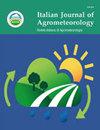小麦生产力和水分利用效率对灌溉、钴和杂草管理的响应
IF 0.8
4区 农林科学
Q2 AGRONOMY
Italian Journal of Agrometeorology-Rivista Italiana Di Agrometeorologia
Pub Date : 2019-06-03
DOI:10.13128/IJAM-287
引用次数: 6
摘要
在埃及国家研究中心农业实验站的两个沙质土壤田间试验中,研究了三种灌溉水平(作物需水量的100%、75%和50%)、五种杂草控制处理(pyroxsulam、mesosulon -methyl、异丙隆+双氟虫腈、手除草和不除草控制处理)、五种钴浓度(0、5、10、15和20 ppm)及其相互作用对小麦生产力、杂草生长和水分利用效率的影响。结果表明,苯妥苏的除草效果最好。与其他所有灌溉处理相比,100%需水量处理对小麦的旗叶面积、叶绿素含量、株高、穗数/m2、粒数/穗、千粒重、秸秆和籽粒产量的影响最大。异丙隆+双氟虫尼处理的产量最高,其次是吡唑胺和甲磺隆-甲基处理。在低肥力土壤中,施用钴可以从水分不足对小麦产量的负面影响中恢复,以15 ppm的速率施用钴可以提高小麦产量。在按作物需水量100%施用焦素和15 ppm钴的情况下,籽粒蛋白质和碳水化合物比例最高,其次是按作物需水量75%施用异丙隆+双氟虫尼,两种互作处理间差异不显著。本文章由计算机程序翻译,如有差异,请以英文原文为准。
Wheat productivity and water use efficiency responses to irrigation, cobalt and weed management
The effect of three irrigation levels (100%, 75% and 50% of crop water requirement), five weed control treatments (pyroxsulam, mesosulfuron-methyl, isoproturon+diflufenican, hand weeding and unweeded check control treatment), five cobalt concentrations (0, 5, 10, 15 and 20 ppm) and their interaction on wheat productivity, weed growth and water use efficiency, were examined in two field experiments in sandy soil at the Agricultural Experimental Station of the National Research Centre, Egypt. The results indicated that pyroxsulam recorded the greatest weed control efficiency. Application of 100% of crop water requirement showed the largest values of flag-leaf area, chlorophyll content, plant height, spikes number/m2, grains number/spike, 1,000 grain weight, straw and grain yield of wheat plants, compared with all other irrigation treatments. Isoproturon+diflufenican followed by pyroxsulam and mesosulfuron-methyl treatments gave the largest grain yield. Application of cobalt resulted in recovery from the negative effects of insufficient water on wheat yield in low fertility soils and using cobalt at a rate of 15 ppm resulted in increased wheat grain yield. The maximum grain yield with largest protein and carbohydrates percentages in grains was obtained by application of 100% of crop water requirement with pyroxsulam and using 15 ppm cobalt, followed by 75% of crop water requirement combined with isoproturon+diflufenican treatment, with insignificant difference between both two interaction treatments.
求助全文
通过发布文献求助,成功后即可免费获取论文全文。
去求助
来源期刊

Italian Journal of Agrometeorology-Rivista Italiana Di Agrometeorologia
AGRONOMY-ENVIRONMENTAL SCIENCES
CiteScore
2.10
自引率
8.30%
发文量
6
期刊介绍:
Among the areas of specific interest of the journal there are: ecophysiology; phenology; plant growth, quality and quantity of production; plant pathology; entomology; welfare conditions of livestocks; soil physics and hydrology; micrometeorology; modeling, simulation and forecasting; remote sensing; territorial planning; geographical information systems and spatialization techniques; instrumentation to measure physical and biological quantities; data validation techniques, agroclimatology; agriculture scientific dissemination; support services for farmers.
 求助内容:
求助内容: 应助结果提醒方式:
应助结果提醒方式:


